Tacos CDMX: into the hungry heart of Mexico City
Mexico's most iconic dish, the taco, isn't just a snack on every street corner in the nation's capital - it's a whole way of life. Plus: what I've been drinking there this week
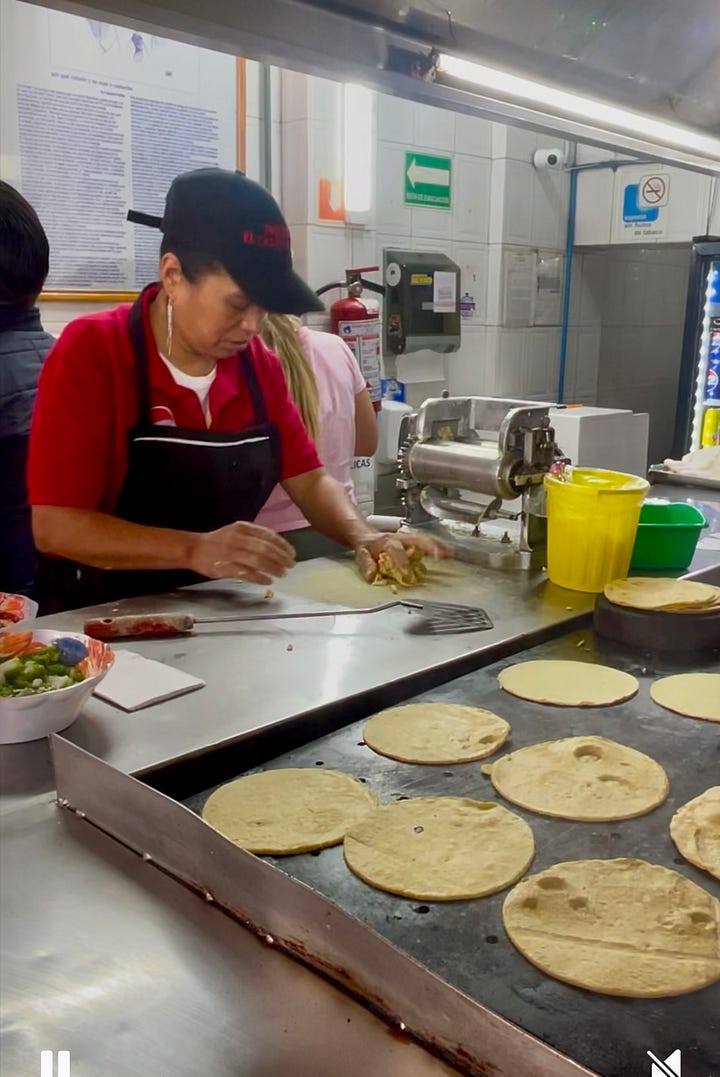
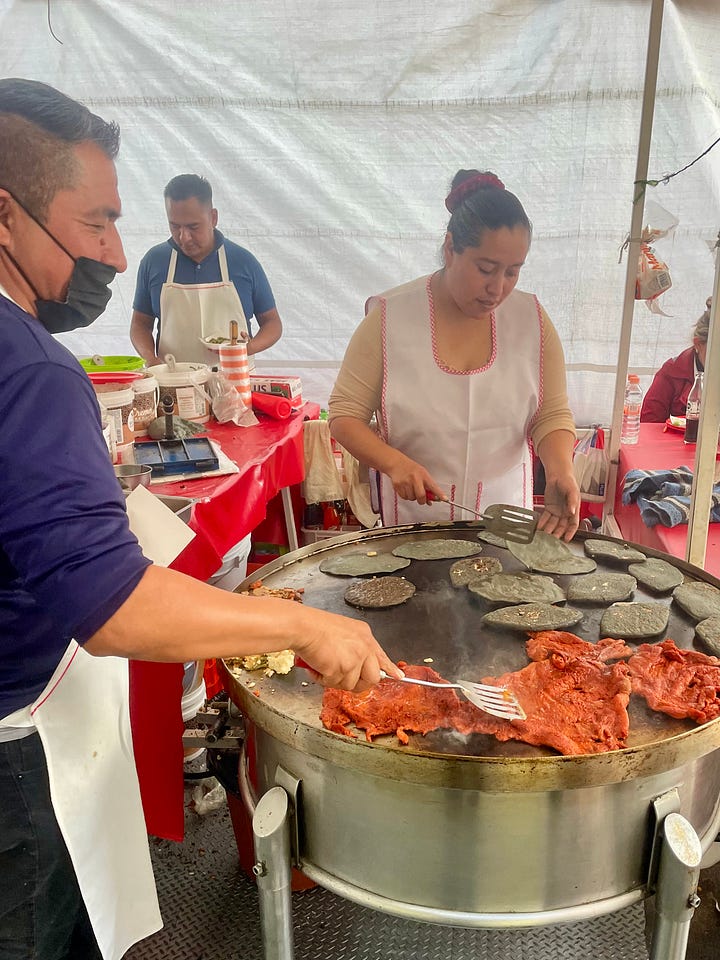
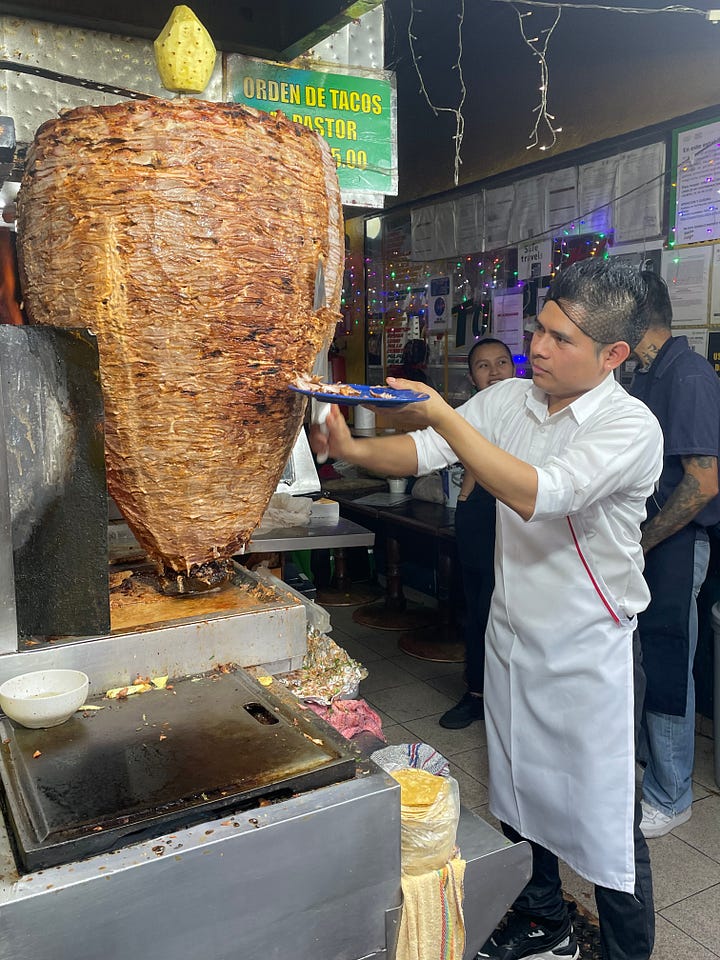
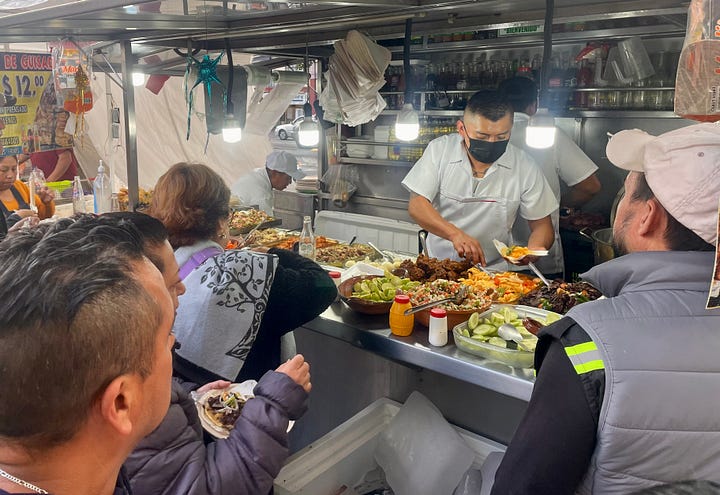
Traffic was stalled on Avenida de los Insurgentes. “Es el caos” (“It’s chaos”), grunted my taxi driver resignedly. I told him I was English and he brightened: “You like Mexican food? Lovely, eh? Tacos?” I confirmed that I did indeed, and that I was writing about them: “Que padre!” (“Cool!”)
This is not an uncommon line of conversation with chilangos, the residents of Mexico City: not only is their food is a source of immense pride, but talking about it almost inevitably leads to a discussion of tacos. For eating tortillas and other corn (maize) foods lies deep in the Mexican psyche.
The ease of growing maize in the fertile Valley of Mexico was the greatest source of abundance for the Mexica (Aztec) people before Hernán Cortés and his Spanish conquistadors arrived in 1519. Maize and its cultivation sat at the heart of Aztec and Maya religious beliefs. One of various theories of taco’s etymology is that it derives from tlahco, meaning "in the middle" in the Aztecs’ Náhuatl language, as the filling in a taco is when you’ve folded it to eat.
Whatever its origins, today Mexico produces more than 27 million tonnes of corn a year and imports nearly that much again. That feeds an estimated appetite of seven to ten tortillas per head daily in this nation of over 130 million people. Maize kernels are cured in lime water so that their skins drop off (a process known as nixtamalisation), after which they are ground into masa flour, made into dough and rolled into tortillas. Then they hit the streets – and in CDMX (as Ciudad de México is invariably abbreviated), from well-heeled, banker-friendly Polanco in the west to the eastern ganglands of Tláhuac and Ciudad Nezahualcóyotl, taco stands are a constant.
It is impossible to overstate Mexicans’ love of snacking. Around metro stations and in public squares like the vast central Zócalo, in every tianguis (street market) and outside the big Hospital General in Roma Sur, a tangle of stalls offers tacos, tamales (a filling in steamed corn dough), tlacoyos, quesadillas, hot meat tortas (sandwiches) and more – most involving corn of some sort. Not only people of all classes but also on-duty cops and security guards stand on the street munching. And in leafy, hip Condesa, where I was staying, at nearly 10pm on weekday nights one foodseller would ride through the streets calling over a loudspeaker, “Ricos tamales oaxaqueños!” (“Lovely Oaxacan tamales!”) to tempt any chilango needing a last snack of the day.
This is not necessarily a question of greed. Mexicans eat their main meal of the day between 2pm and 5pm (many restaurants shut at 8pm) – so grabbing a bite in the early afternoon or as a mid-morning snack is logical enough. What’s more, Mexico City’s vastness – an estimated 23 million people, the largest megalopolis in the Americas – and its jammed metros and near-apocalyptic traffic can make it hard for workers to get home in time to eat. Enter salvation, wrapped in a disc of corn.
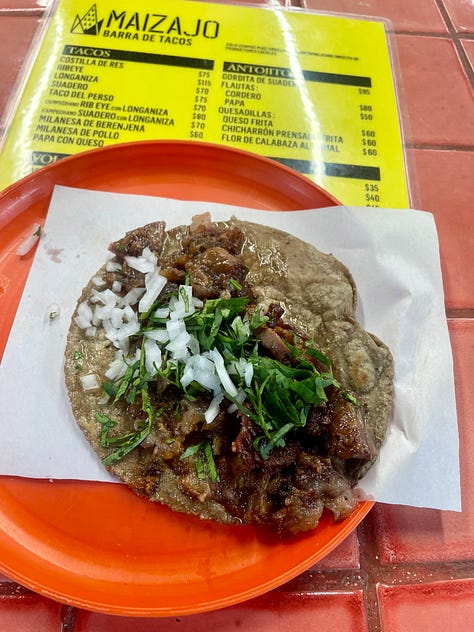
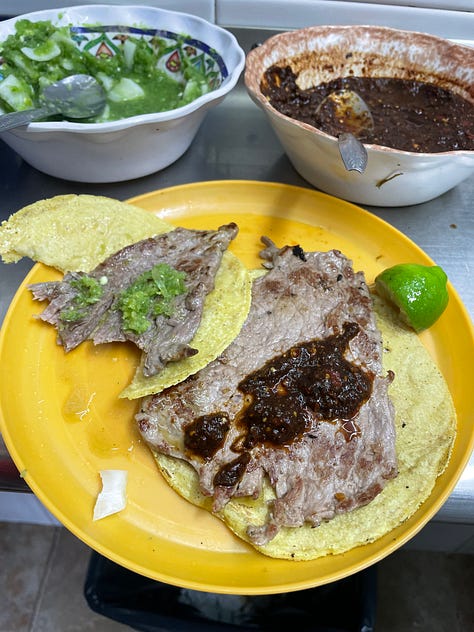

So what to choose in your taco? Many would argue that the quintessential Mexico City taco is pastor, spicy pork cooked on shawarma-style on an upright spit (see photo above.) The middle-eastern resemblance is not coincidental: it was invented by some of the hundreds of thousands of Lebanese who emigrated to Mexico in the late nineteenth and early twentieth century.
Other taco favourites include carnitas (braised, fried and shredded meat, usually pork), chicharrón (pork belly with crackling), longaniza (chorizo-type pork sausage), barbacoa (barbecued meat) and cochinita pibil (Yucatán-style pork, slow-roasted with citrusy, red-coloured achiote paste and orange). Straightforward bistec (steak) and milanese (veal or beef escalope) are wildly popular too. On the stewier end are guisados such as chicken and other meats in mole sauce, and pork and other things in red adobo sauce. I have a particular fondness for birria, a rich stew from Jalisco, traditionally goat but more normally beef in Mexico City.
But all are served in or with corn tortillas – and almost whatever filling you have, you’ll be asked, ““con todo?” – “with everything?”, ie lime, chopped onion and coriander.
And even if you’re not eating tacos as such, tortillas will often feature in your meal. In most traditional cantinas and restaurants (cantinas are more about drinking than eating), waiters put a pot of tacos on your table without asking, along with the equally automatic slices of lime. At the venerable Gallo d’Oro, founded 1874, in the teeming centro, I ate a huge serving of cabrito (goat kid) unadorned apart from French fries – with tortillas, lime and green salsa. “There is no such thing as a light Mexican meal,” writes American journalist David Lida in his classic exploration of the city, First Stop in the New World.
Yes: this is a meaty cuisine. My English friend James, with whom I was staying, is pescatarian – so fish tacos were an obvious choice. Originating in Pacific Baja California, these are popular in Mexico City though less common here. But we enjoyed the tacos of deep-fried fish and shrimp, and smoked marlin, at María La Pescadora in Roma Norte. They also serve the other key corn-based accompaniment to fish: tostadas (their raw tuna ones are divine.)
There are a few other taco choices for vegetarians. In the Condesa tianguis I sampled the black, oval pies I’d seen cooking on many street comales (large, flat griddles): these are tlacoyos, an ancient corn snack. The woman behind the stall took a big handful of dark dough made from masa flour, flattened it into a circle in her hands, added a filling of beans and cheese, then folded it over and placed it on the comal. She served it sprinkled with nopales (sliced prickly pear cactus pads) and more cheese. I ate a daintier version of the same dish in the excellent café at the unmissable Museo Nacional de Antropología: there’s nothing to sharpen your appetite for corn-based dishes like gazing at statues of scary Aztec gods such as the feathered serpent, Quetzalcoatl, and rain god Tláloc.
And thus the list of corn-based dishes goes on, reinterpreted in high-end restaurants as well as at street puestos. At Roma Norte’s Pargot, possibly the best place I ate at in Mexico City and easily worthy of a Michelin star, I enjoyed, among other extraordinary creations, a hearty, very rich oxtail tamal. And at Los Danzantes, on Coyoacán’s lovely Plaza Centenario, I ate the most intense expression of another corn delicacy, huitlacoche, a dark fungus that grows on maize, sometimes called Mexican truffle. It’s most commonly used in soup but here was a served as a confit with olive oil and herbs, accompanied by avocado and a broken tostada.
So how high can you take the humble taco? Last May the dish received the ultimate accolade with the award of a Michelin star to a Mexico City stall, Av. Ribera de San Cosme’s Taquería El Califa de León, in the San Rafael neighbourhood. Their tacos (just four on the menu, all meat) are indeed delicious, and affordable, starting at 53 pesos apiece (£2.10/US$2.50). But how anyone is supposed to make a meaningful comparison between this food wolfed at the stand-up counter and other one-stars such as, say, London’s Chez Bruce, or indeed Mexico City’s exquisite Em, remains unclear (I suspect this resulted from one of Michelin’s regular spasms over being thought too stuffy and French.)
El Califa de León does highlight one key factor in the best tacos: the freshness of the tortillas. This might sound obvious, but most street stalls, inevitably, don’t have space or staff to make their own. At El Califa, one cook rolls out the tortillas from dough next to the grill, throwing them on as they are made; they puff up and blister next to the sizzling meat that will fill them.
This is also the secret of the tacos at other memorable taquería I ate at, Maizajo, in Condesa. Maizajo make and sell tortillas fresh in the same open kitchen that makes the tacos that end up on your plate: I enjoyed a sublime taco suadero (a cut of beef) and an even better flauta de cordero (lamb, unusually for Mexico City, wrapped in a crispy tube of tortilla).
Can the taco be made yet fancier? Of course it can. At Mexico City’s most famous restaurant, the two-Michelin-star Pujol, chef Enrique Olvera offers, amongst other things, an entire menu built around tacos (cost: $3,332MX = £132/US$160). Sadly, I didn’t manage to get a reservation this trip; I can, however, confirm that the duck carnitas at Olvera’s New York City venture, Cosme, are near-life-changing.
Pujol and Cosme are a far cry from the taquerías off Av de los Insurgentes in Roma Sur, their food consumed off plastic plates amid the noise, exhaust fumes and general madness that is Mexico City. Which is, of course, part of their appeal. Shortly before I got out of one cab down there, the driver of a minibus jumped out next to us and started squaring up to the driver behind him, fists raised, over some alleged near-miss. Fortunately the violence was only verbal: “Hijo de tu pinche madre!” “Pendejo!” (loosely: “Son of a fucking bitch!” “Asshole!”) “A cultural exchange for you!” laughed my driver. Between taxistas and tacos, the life of Mexico City’s streets is never less than intense – and tasty.
Below: a tortilla shop in action, Av. Campeche, Roma Sur
What I’ve been drinking this week
Last week I mentioned the beer, wine and mezcalitas I’d been, er, researching on this trip. Here are some of the other bars and their cocktails I’ve enjoyed,
Sarde, Roma Norte - Sarde is one of the very few restaurants in Mexico City where I did not eat any dishes involving corn, though I did enjoy very fine seafood there (the octopus on a crispy black rice base was revelatory.) But they also do great cocktails, notably a good Carajillo, made of Licor 43, a vanilla and herb-based liqueur, and espresso coffee: think of a slightly sweeter take on the espresso martini.
Traspatio, Roma Norte - a very relaxed bar with greenery, part open to the sky during the daytime. The cocktail list is short but well executed: their aguacate involved the eponymous avocado, mashed and strained, as well as mezcal and Licor 43. Wonderfully fresh and green yet pretty strong: just as well I stopped at one before lunch.
Felina, Condesa - Felina is a laid-back, pretty cool bar in a slightly out-of-the-way bit of Condesa where I ended up after wandering around the neighbourhood on a warm afternoon. In need of refreshment, their mojito was perfect - one of a number of rum-based cocktails on offer, which is slightly unusual for Mexico City.
La Clandestina, Condesa - I mentioned this brilliant bar’s mezcals last week but they do great cocktails too. Their Habanero combines chilli warmth with Espadín-based mezcal and orange liqueur - gorgeous.




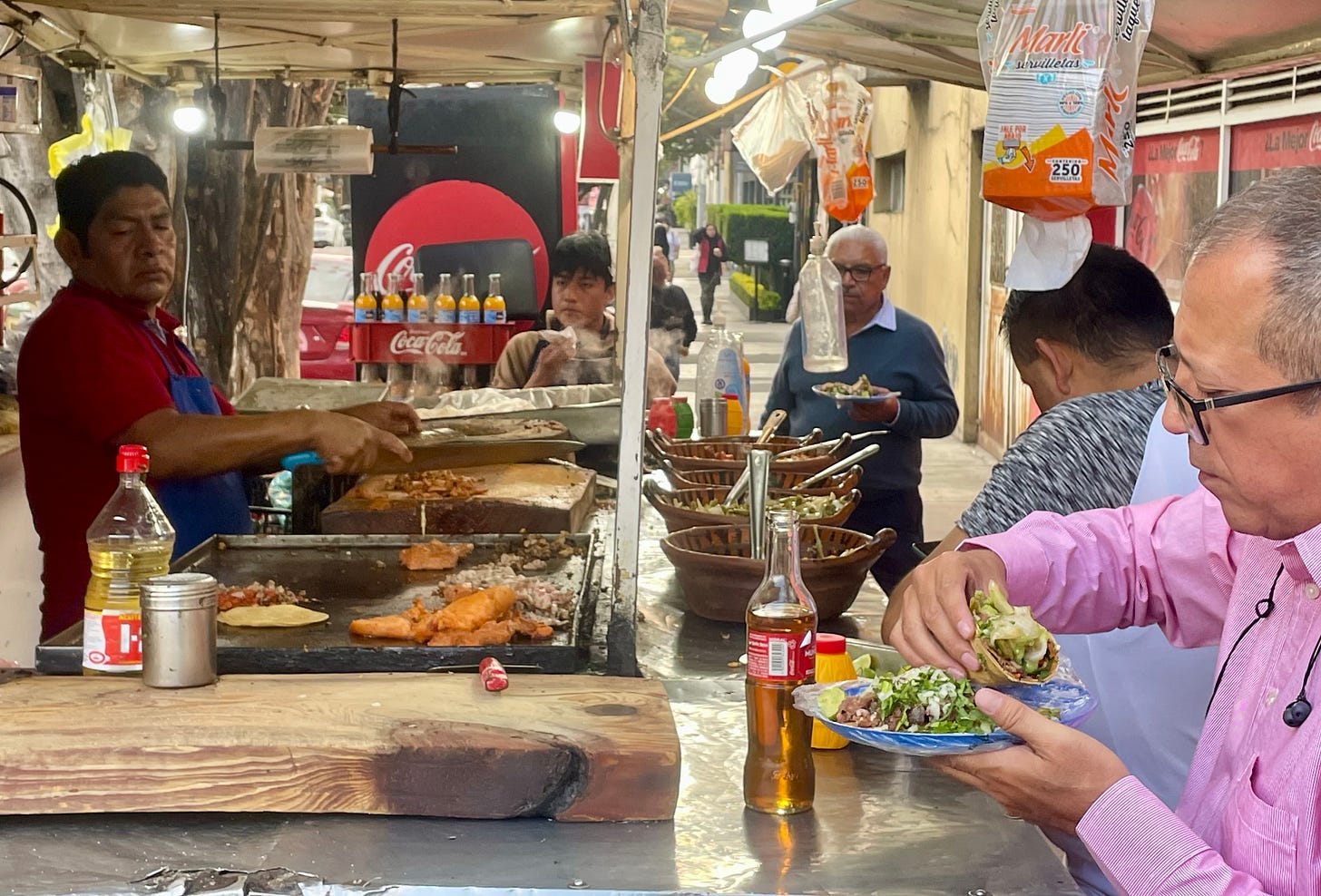
Loved this piece!
Fabulous up-date! Thanks so much, Andy. I remember Diana Kennedy from old times in DF and Oaxaca in youth (mine rather than Ms. Kennedy's).